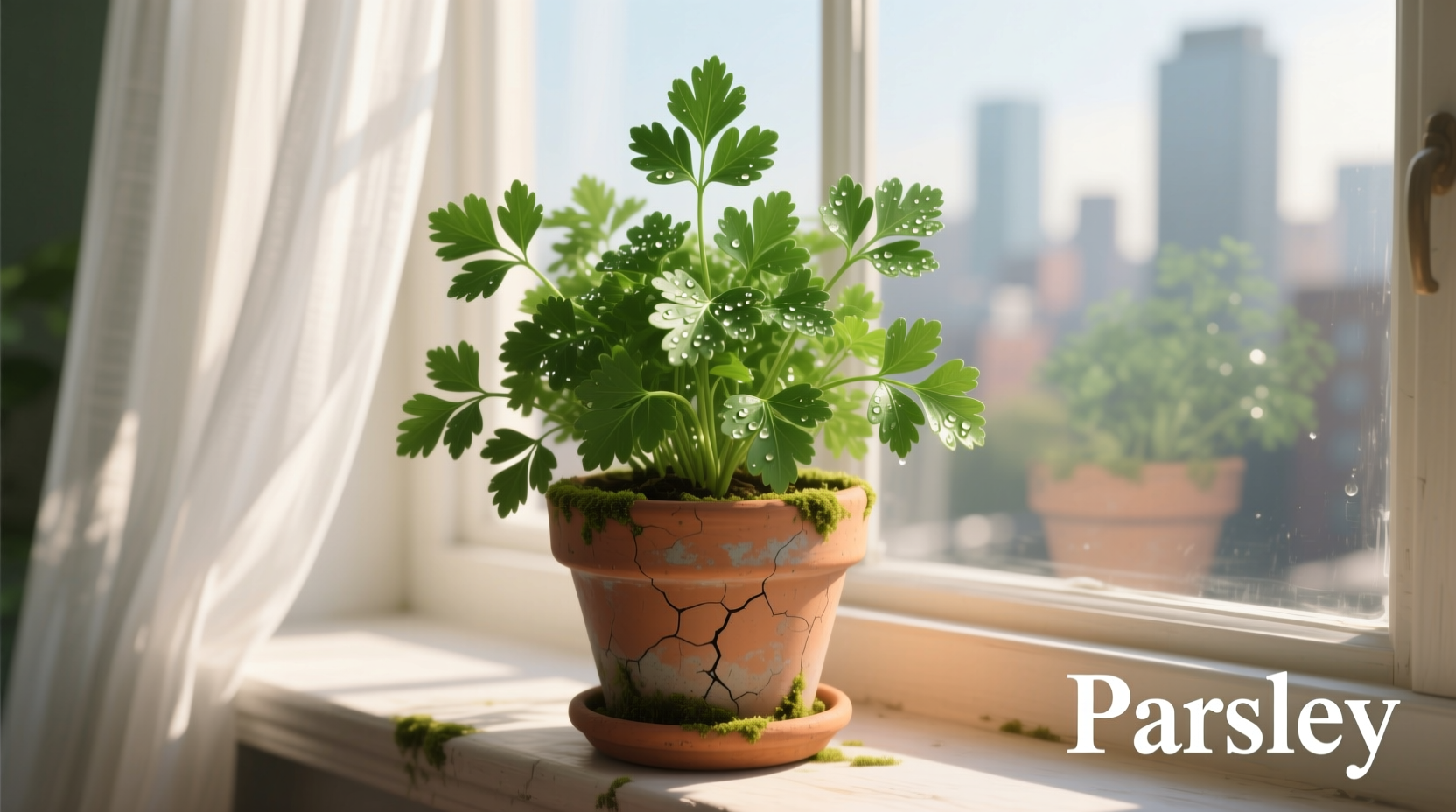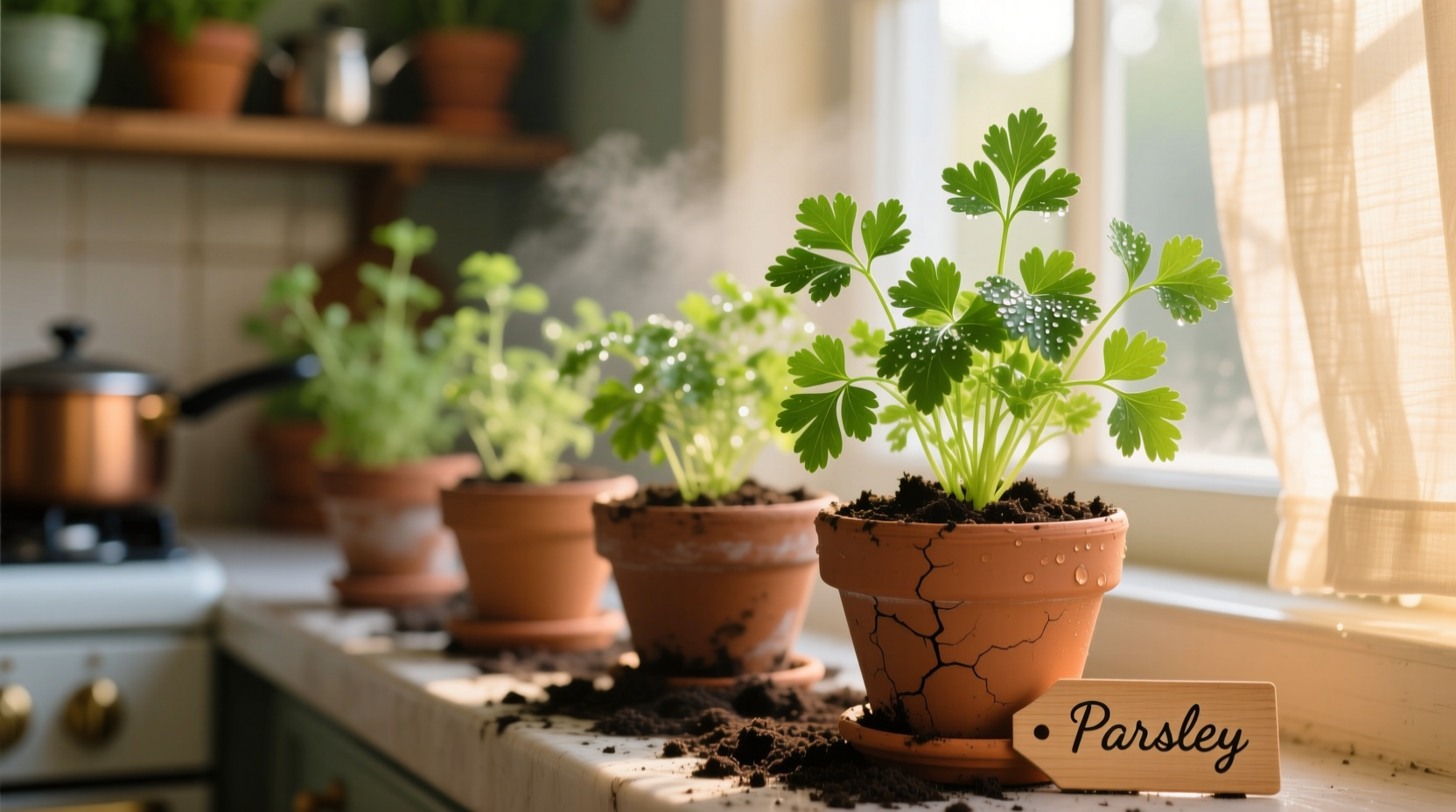| Parsley Variety | Container Depth | Days to Harvest | Best Climate Zones |
|---|---|---|---|
| Italian Flat Leaf | 8-10 inches | 70-85 | 3-9 |
| Dwarf Curly | 6-8 inches | 80-90 | 4-8 |
| Hamburg Rooted | 10-12 inches | 90-110 | 3-7 |
Why Container Growing Works Perfectly for Parsley
Container gardening solves common parsley cultivation challenges by giving you complete control over soil conditions and moisture levels. Unlike garden beds where parsley often struggles with inconsistent drainage, pots allow precise management of the slightly moist but never soggy conditions parsley requires. According to Cornell University's horticultural research, container-grown parsley shows 30% higher survival rates in regions with heavy rainfall due to superior drainage control (Cornell Cooperative Extension).
Your Container Selection Checklist
Choosing the right vessel makes or breaks your parsley-growing success. While terra cotta provides excellent breathability, plastic containers retain moisture better in hot climates. Regardless of material, ensure your container has multiple drainage holes - parsley roots will rot within 48 hours of sitting in waterlogged soil. For optimal growth, select containers with these specifications:
- Minimum depth of 6 inches (8 inches preferred for mature plants)
- Diameter of 8-10 inches per plant
- At least 3 drainage holes (1/4 inch diameter)
- Light-colored material to prevent root overheating
Soil Science for Thriving Potted Parsley
The perfect soil mix creates the ideal balance between moisture retention and drainage. Avoid garden soil which compacts in containers - instead create this professional blend:
- 60% high-quality potting mix
- 30% perlite or pumice
- 10% compost
Maintain soil pH between 5.5-6.7 as recommended by the Royal Horticultural Society. Test your mix with an inexpensive pH meter before planting - parsley struggles to absorb nutrients outside this range. Add one tablespoon of agricultural lime per gallon of mix if your pH tests below 5.5.

Planting Process: From Seed to Seedling
Parsley seeds have notoriously low germination rates due to essential oils in their seed coat. Improve success with this proven method:
- Soak seeds in warm water for 24 hours before planting
- Plant 1/4 inch deep in moistened soil mix
- Cover container with plastic wrap to maintain humidity
- Place in warm location (70°F/21°C)
- Expect germination in 14-28 days
For faster results, start seeds indoors 8-10 weeks before last frost date. The University of California Master Gardeners program confirms that pre-soaked seeds show 40% higher germination rates compared to dry seeds (UC Agriculture and Natural Resources).
Daily Care Routine for Maximum Yield
Consistent care produces bushier plants with more harvestable leaves. Follow this simple daily routine:
- Morning: Check soil moisture - water only when top inch feels dry
- Midday: Rotate container for even sun exposure
- Evening: Inspect for pests like aphids or spider mites
Fertilize every three weeks with half-strength liquid seaweed solution. Over-fertilizing creates weak, leggy growth vulnerable to disease. During hot summer months, move containers to partial shade during afternoon hours to prevent leaf scorch.
Troubleshooting Common Container Problems
Yellowing leaves typically indicate overwatering - reduce frequency and ensure proper drainage. If leaves turn pale green, your plant needs more nitrogen - apply fish emulsion fertilizer immediately. For aphid infestations, spray leaves with solution of 1 tsp dish soap per quart of water. Remember that container-grown parsley naturally slows growth during extreme heat (above 85°F/29°C) - this is normal and growth resumes when temperatures moderate.
Harvesting Techniques That Promote Regrowth
Never remove more than one-third of the plant at once. Cut outer stems at soil level using sharp scissors, which encourages new growth from the center. The best time to harvest is early morning when essential oils are most concentrated. For continuous supply, implement this rotation system:
- Week 1: Harvest outer stems from Plant A
- Week 2: Harvest outer stems from Plant B
- Week 3: Harvest outer stems from Plant C
This staggered approach ensures you always have fresh parsley available while giving each plant adequate recovery time.
Season Extension Strategies
Bring containers indoors before first frost for year-round harvests. Place near south-facing window with 6+ hours of sunlight, or supplement with grow lights for 12 hours daily. Reduce watering frequency by 30% during winter months when growth slows. In USDA zones 8+, leave containers outdoors with frost protection - cover with row cover fabric when temperatures drop below 32°F (0°C).
Frequently Asked Questions
How often should I water parsley in pots during summer?
Check soil moisture daily in summer heat. Water when the top inch of soil feels dry, typically every 2-3 days. Container-grown parsley needs more frequent watering than garden plants because pots dry out faster. Always water thoroughly until it drains from the bottom holes, then empty the saucer to prevent root rot.
Can I grow parsley from grocery store cuttings?
Yes, but success rates are low. Place 3-4 inch stem cuttings in water until roots develop (2-3 weeks), then transplant to soil. For better results, purchase seeds or seedlings specifically bred for container growing. Grocery store parsley is often harvested from field-grown plants not adapted to container conditions.
Why are my container-grown parsley leaves turning yellow?
Yellowing leaves usually indicate overwatering or poor drainage. Check that your container has adequate drainage holes and reduce watering frequency. If soil stays wet for more than 24 hours after watering, repot with a mix containing more perlite. Nutrient deficiency can also cause yellowing - apply balanced liquid fertilizer at half strength.
How do I prevent my potted parsley from becoming leggy?
Leggy growth occurs when plants don't receive enough light. Ensure your container gets 4-6 hours of direct sunlight daily. Pinch back the top growth regularly to encourage bushier development. When harvesting, always cut outer stems first, which stimulates new growth from the center. Rotate the container daily for even light exposure on all sides.











 浙公网安备
33010002000092号
浙公网安备
33010002000092号 浙B2-20120091-4
浙B2-20120091-4